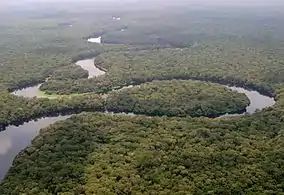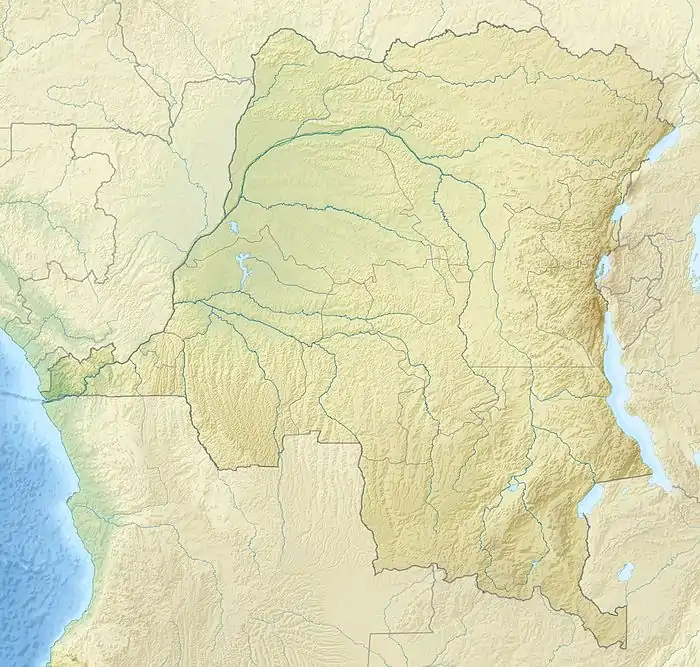Salonga National Park
Salonga National Park is a national park in the Democratic Republic of the Congo located in the Congo River basin. It is Africa's largest tropical rainforest reserve covering about 36,000 km2 or 3,600,000 hectares (8,900,000 acres). It extends into the provinces of Mai Ndombe, Equateur, Kasaï and Sankuru.
| Salonga National Park | |
|---|---|
IUCN category II (national park) | |
 View of a river in the Salonga National Park in 2005 | |
 | |
| Location | Democratic Republic of the Congo |
| Coordinates | 2°S 21°E |
| Area | 36,000 km2 (14,000 sq mi) |
| Established | 1970 |
| Governing body | l'Institut Congolais pour la Conservation de la Nature (ICCN) |
| Type | Natural |
| Criteria | vii, x |
| Designated | 1984 (8th session) |
| Reference no. | 280 |
| State Party | |
| Region | Africa |
| Endangered | 1999–... |
Geography
The park is in an area of rainforest about halfway between Kinshasa, the capital, and Kisangani. There are no roads and most of the park is accessible only by river. CTT (www.congotravelandtours.com) is the only operator and logistics company currently organizing overwater transport from the Congo River into the Salonga Park via minor rivers. The southern region inhabited by the Iyaelima people is accessible via the Lokoro River, which flows through the center and northern parts of the park, and the Lula River in the south.
History
The Salonga National Park was established as the Tshuapa National Park in 1956, and gained its present boundaries with a 1970 presidential decree by President Mobutu Sese Seko. It was registered as a UNESCO World Heritage Site in 1984.[1] Due to the civil war in the eastern half of the country, it was added to the List of World Heritage in Danger in 1999.
The park is co-managed by the Institut Congolais pour la Conservation de la Nature and the World Wide Fund for Nature since 2015. Extensive consultation is ongoing,[2] with the two main populations living within the park; the Iyaelima, the last remaining residents of the park [1] and the Kitawalistes, a religious sect who installed them-self in the park just after its creation. An intense collaboration exists between the park guards and the Iyaelima, as Iyaelima villages are used as guard posts. It is known that bonobo densities are highest around Iyaelima villages which shows that they cause no threat to the park's emblematic species.[3]
Wildlife
Animals in the park include bonobos, Dryas monkeys, Thollon's red colobus, Congo peafowl, leopards, forest elephants, and African slender-snouted crocodiles.
Other animals present include the long-tailed pangolin, giant pangolin, tree pangolin, Angolan slender mongoose, aquatic genet, hippopotamus, the African golden cat, bushpig, bongo, yellow-backed duiker, sitatunga, okapi, bushbuck, water chevrotain and forest buffalo.
There are many birds present and some of the larger ones are the cattle egret, black stork and yellow-billed stork.[4] Some of its species are endemic to the country, and many are of high conservation concern.
The southern region has been the location for studies of bonobos in the wild.[5] There are much higher populations of bonobos near the Iyaelima settlements than elsewhere in the park, apparently because the Iyaelima do not harm them and are playing a strong role in their conservation.[5]
References
- Hopson, Mark (2011). "The Wilderness Myth: How the Failure of the American National Park Model Threatens the Survival of the Iyaelima Tribe and the Bonobo Chimpanzee". Earth Jurisprudence and Environmental Justice Journal. 1 (1).
- CERDI-BAS (2016), Etude Stratégique des populations résidentes dans le parc national de la Salonga
- Furuichi, Takeshi; Thompson, Jo Myers (2008). The bonobos: behavior, ecology, and conservation. Springer. p. 239. ISBN 0-387-74785-0.CS1 maint: ref=harv (link)
- "Salonga National Park". UNESCO. Retrieved 2013-12-14.
- Falk, John (2008). "Why the Bonobos Need a Radio and Other (Unlikely) Lessons From Deepest Congo". National Geographic. Archived from the original on 2012-04-03.
Sources
- Furuichi, Takeshi; Thompson, Jo Myers (2008). The bonobos: behavior, ecology, and conservation. Springer. ISBN 0-387-74785-0.
- INCEF - Conservation and Health in Salonga
- Wildlife Conservation Society
- UNESCO Salonga National Park Site
- WCMC Site Data Sheet